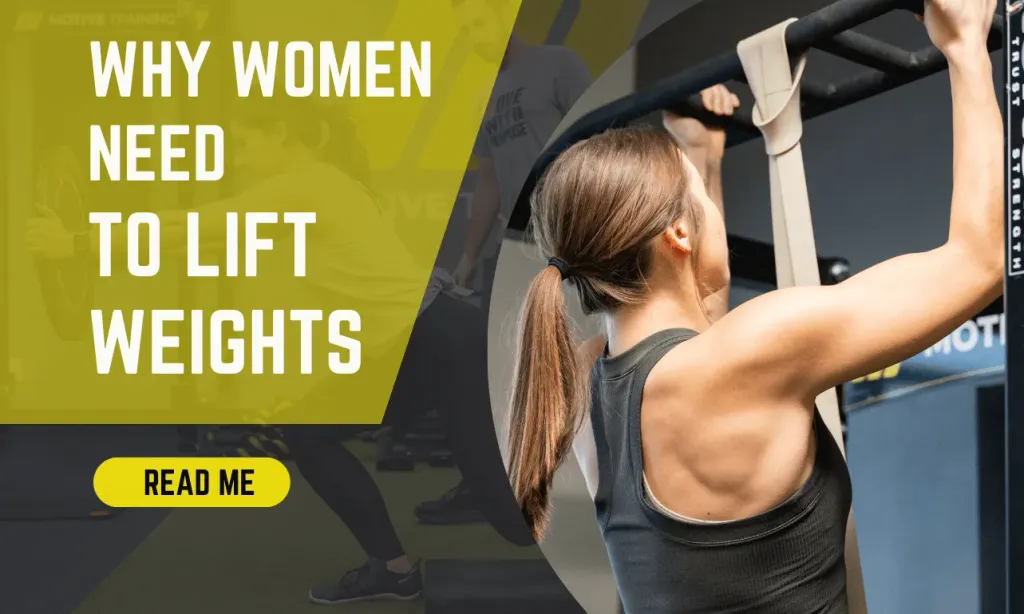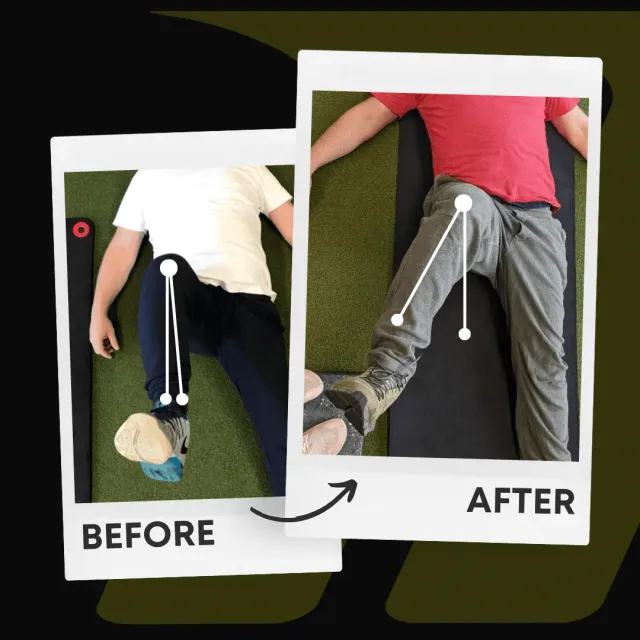Why Women Need To Lift Weights
January 21, 2023 | Fitness

Does the idea of women strength training scare you? It shouldn’t, but there’s still a misconception about strength training that we want to squash today. First, let’s hear what some of our clients have said.
“I’m not looking to get muscly or bulky, I just want to lean out a little bit.”
“I want to get those shoulder and arm lines. Again, not really muscly, I just want to be able to see my muscles.”
“Bigger butt.”
“I want to get rid of these arm flaps. I don’t want to be able to take flight if I wave my arms fast enough.”
That last one sounds slightly embellished, but those were our client’s exact words; we thought it was so great that we wrote it down in our assessment notes.
We’ve heard it all
In our time as personal trainers, almost without fail, every single woman has said one of these sentences in one way or another. Regardless of their current fitness status or specific personal goals, they all shared a common desire: a tight and lean physique. However, this desire is always coupled with fear and aversion to becoming too muscly or manly in appearance. Unfortunately, yet understandably, many women mistake strength training as the culprit. So, they turn to all types and flavors of cardio to reach their goals. It’s a sad truth and a misconception, but one that can be understood. The ironic truth of the matter is that incorporating strength training into a fitness routine is actually the answer to creating a well-rounded, truly strong, and lean figure.
Alright. You’re telling me strength training is the solution for getting that lean, beach-ready physique I’ve always wanted? Let’s say I believe you. Why isn’t every woman out there doing strength training, then? Why are kickboxing, barre, and cycling classes full of women trying to get the same results as me but are instead not taking the route you’re advising?
Good question.
First and foremost, we do not hate any of the above fitness trends. On the contrary, we’re all for getting the body moving. That’s the first and most crucial step, and if that’s what it takes to finally get you to care about your health and activity level, we fully support it. However, if your goal is to refine your physique in any way, you need to do more than move; you need to start lifting weights.
Where Did The Industry Go Wrong?
Women have been told for decades that the route to better fitness is through uber-restrictive diets combined with endless bouts of cardio. For one, this is unsustainable, and two, it makes for a miserable existence, as we’re sure you’ve encountered in your journey.
For as long as we can remember, women’s fitness has been almost entirely focused on becoming skinny; this is and should no longer be the case.
Strong is the new skinny.
Being strong is the key to being tight and lean, and to look strong, you’ve gotta get strong.
This article aims to rectify as much misinformation surrounding strength training as possible, so let’s get to it.
MYTH #1: Strength training is only for powerlifters or people who want to squat 300 lbs.
FACT: Everyone, young and old, male and female, budding fitness enthusiast, or an experienced athlete, can and will benefit from some form of strength training.
The term strength is commonly used to describe one’s ability to overcome resistance. Some might take this to mean that being strong is equivalent to picking up super-heavy weights. However, that is not always the case.
Strength training, at its core, is all about imposing demands on your body that force it to adapt in ways that are favorable to your physique (e.g., building muscle).
The key here is that you’re not bound to do only max-effort 250-pound deadlifts to make your glutes more shapely, nor do you need to do 500 reps of glute kickbacks for 45 minutes.
The goal is to meet somewhere in the middle by using a variety of weights, reps, sets, and tempos (i.e., how fast you perform an exercise.) For instance, some phases of your exercise program should include higher-weight, lower-rep work, while other parts should have lower-weight, higher-rep work.
If any of this is confusing or you want help customizing your exercise program, reach out to us here.
The simple truth is that lifting weights will make you stronger and leaner, and the research supports this (1, 2).
MYTH #2: Strength training will make me too masculine, muscular, stocky, grow a mustache, etc.
FACT: It won’t. Female genetics ensure that none of these awful nightmares come true.
We wish putting on muscle were that easy, and so does every other man reading this. But, unfortunately, the average gym bro struggles to pack on muscle, even after doing chest and arms for the 5th time this week.
You will never get bulky or masculine from strength training because you were biologically built not to appear that way. Simply put, you won’t outgrow your genetic potential as a female.
One reason is that bone structure and total body mass impact your maximum muscle potential (3). If you’re smaller, structurally speaking, you’re less likely to put on a boatload of muscle mass. Men put on more muscle, or appear to, due to their considerably larger bone structures and higher bone densities. Conversely, your female structure makes you less likely to be overly muscular. The only way you’re going to pack on insane amounts of muscle is by introducing exogenous testosterone into the body (e.g., performance-enhancing drugs.) (3)
The cool thing is you can build as much relative muscle as a man can; it’s just that your base level of muscle is lower than a man’s. If you had the same base level of muscle…you would be a man, and you’re not a man…so, ipso facto, you won’t get masculine.
It’s time to stop blaming weights for making you bulky and time to start addressing the elephant in the room: the excess calories you’re eating. Ultimately, what you’re putting into your mouth greatly influences your bulkiness more than any weight you lift in the gym.
So, lift all you want, and don’t worry that you’ll look like Schwarzenegger.
Beyond Building Muscle
Being strong and lean is beneficial, but there are some more subtle advantages to women strength training that we need to address.
Benefit #1 – You will build confidence in and outside the gym
Ask any of our male and female clients; they’ve all expressed joy when finally feeling comfortable in the gym. Being able to load up a barbell and pick it up off the floor like a boss is one of the best feelings in the world.
Furthermore, having a developed base of strength helps outside of the gym. Not only will you feel more confident because you’re stronger, but the feeling of being strong in and of itself is also certainly a mood booster.
A recent study examined the emotional, physical, and psychological effects of strength training on women 40 and up. (4) “The Strong Woman Program” focused on this demographic with the primary intent of “maintaining strength, function, and independence.” This strength program was shown to greatly increase body image, quality of life, and ability to participate in physical activity while simultaneously decreasing anxiety and depression symptoms resulting from improved body image.
Learning to lift weights and be confident in the gym will leak into more aspects of your life than you thought possible.
Benefit #2 – You will improve your mental and emotional well-being
Your confidence is tied to your mood and vice versa, so it should be no surprise that strength training improves your mental and emotional state. A review done at Ohio State (yeah, we know, don’t hate us, you Michiganders) examined 16 studies done on resistance training and the effects it had on the participants.
Anxiety symptoms were shown to be drastically reduced post-training. Frequency, duration, and intensity didn’t seem to cause many variations. In other words, the simple act of resistance training was enough to elicit desirable effects on mood.
Another study performed over 11 years on 33,000 people showed that resistance training a couple of times a week could help prevent depression. (5)
Many of us have struggled with depression and mood swings just like you, but we find solace in lifting weights, as it helps us curtail extreme mood changes.
Benefit #3 – You will thank yourself for years to come
Getting old might seem daunting, but getting older and weaker is legitimately frightening.
Sarcopenia is the term used for age-related muscle loss, and it has been linked to more falls, incurring trauma, declining function (i.e., not able to perform activities of daily living), struggling with disabilities, having a poor quality of life, nursing home placement, and mortality (6). In other words, getting old and frail is truly scary.
Strength training now is crucial to help fight muscle loss associated with aging. Don’t believe me? Ask anyone over 60, and they will tell you the same thing: they either lift weights or wish they did. Don’t be the latter.
Conclusion
Alright, now that you’re thoroughly convinced to hop on the strength training train, it’s time to start. It can be a daunting prospect, we know. But, we’ve been there, too, not long ago.
We floundered around in the gym for a bit, did a lot of our research, and asked people that we figured probably knew more than us for some help. It worked, but it took much longer than it would’ve if we had sought professional help from a qualified coach. This will ensure that you establish correct habits and form right from the start. It’ll keep you from hurting yourself and create an environment for accelerated growth and accountability.
Reach out to one in your area or if you’re in the Austin TX, area, We hear the folks over at Motive Training are pretty solid and know their stuff. 😉 If you don’t have access to a qualified coach or a good trainer, do your best with what knowledge you can get from reputable sources and start moving.
Either way, do your research. Find out what you’re interested in, and reach out to a qualified coach.
Learn something new. Try it on for size. Do it again.
Women strength training should be the norm. So, just make it happen.
References
- Increasing Lean Mass and Strength: A Comparison of High Frequency Strength Training to Lower Frequency Strength Training
- Strength training and body composition in middle-age women
- Males have larger skeletal size and bone mass than females, despite comparable body size
- Design and National Dissemination of the StrongWomen Community Strength Training Program
- Exercise and the Prevention of Depression: Results of the HUNT Cohort Study
- Sarcopenia influences fall-related injuries in community-dwelling older adults
Written by

Motive Training Staff
We’ll teach you how to move with purpose so you can lead a healthy, strong, and pain-free life. Our headquarters are in Austin, TX, but you can work with us online by signing up for KINSTRETCH Online or digging deep into one of our Motive Mobility Blueprints.




